Gériatrie et Psychologie Neuropsychiatrie du Vieillissement
MENUFrailty in elderly: a brief review Volume 15, issue 2, Juin 2017
Authors
1 Inserm U1219, Bordeaux, France
2 Isped, Université de Bordeaux, Université de Bordeaux, France
3 Département de gériatrie, Centre Hospitalier Villeneuve-sur-Lot, France
4 Gérontopôle de Toulouse, France
5 Department of Geriatrics, Instituto Nacional de Ciencias Médicas y Nutrición Salvador Zubirán, Mexico City, Mexico
* Tirés à part
- Key words: frailty, elderly, public health
- DOI : 10.1684/pnv.2017.0670
- Page(s) : 127-37
- Published in: 2017
The identification of frail older persons is a public health priority. Frailty is defined as an extreme vulnerability of the organism to endogenous and exogenous stressors, a syndrome that exposes the individual at higher risk of negative health-related outcomes as well as a transition phase between successful aging and disability. The theoretical concept of frailty is largely agreed, its practical translation still presents some limitations due to the existence of multiple tools and operational definition. In this brief review, we would like to clarify the frailty concept regarding scientific literature.


